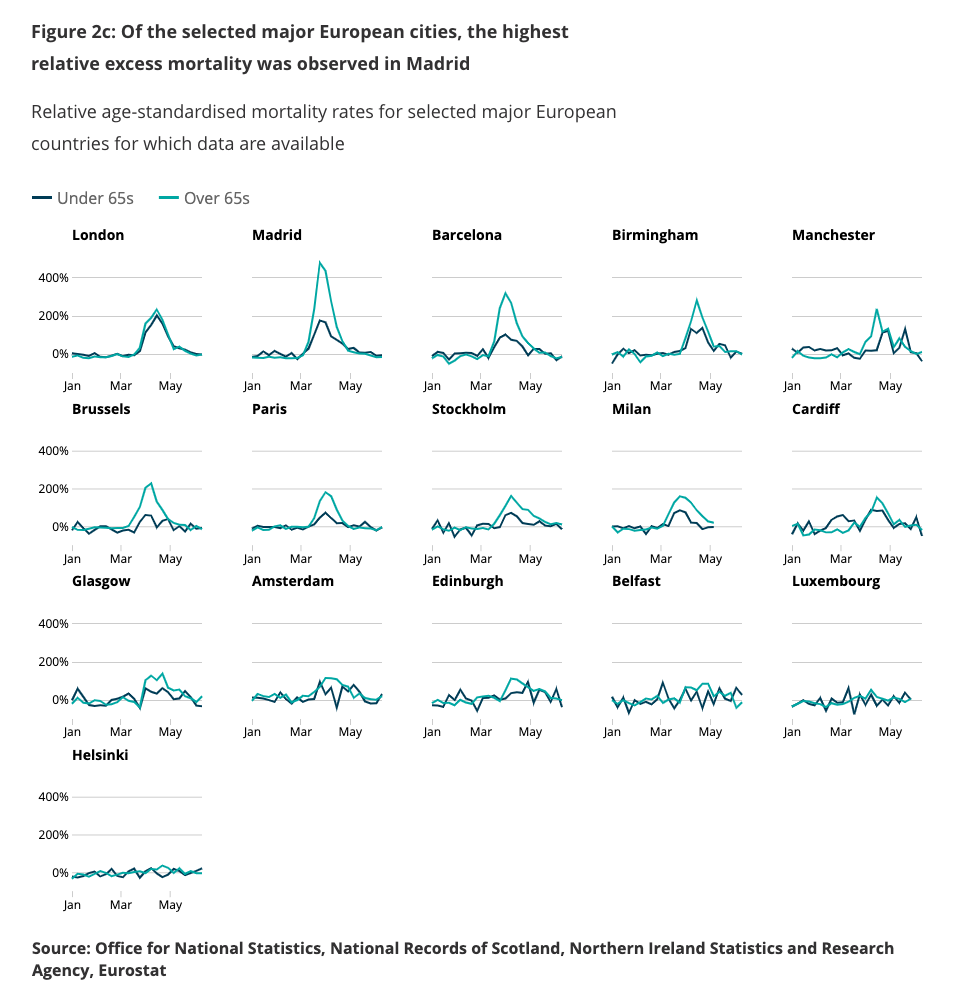On 12 May, the government stopped publishing international comparisons of its Covid-19 death toll in the daily press briefings. The argument was that the data wasn’t helpful, and perhaps even misleading: the way calculations were carried out varied country-by-country, with each nation on a different timescale when experiencing the peak of infections and death. There would be a time for international comparisons, but that time wasn’t now.
Today, the ONS picks up where the press briefings left off, comparing excess mortality rates throughout Europe. The data is not specifically calculating Covid-19 deaths, but rather all causes of mortality on a five-year average. This is the metric the UK’s chief medical officer Chris Whitty described as ‘key’ for determining how successful the government is at handling the crisis.
Excess deaths was the metric the UK’s chief medical officer Chris Whitty described as ‘key’
But the data revelations do not bode well for Britain. So far, England has the highest number of excess deaths in Europe, and the second-highest national peak of excess deaths: ‘The highest peak excess mortality was in Madrid at 432.7 per cent (week ending 27 March) while in the UK, Birmingham had the highest peak excess mortality of any major British city at 249.7 per cent (week ending 17 April).’ But it’s not just bad news for England: Scotland, Wales and Northern Ireland are all in the top eight countries with the highest number of excess deaths, cooling the theory that public health has been handled in a dramatically superior or inferior way across the four regions.

The most generous interpretation of today’s data is that the ONS is compiling calculations that still vary between countries. Just a few weeks back it was revealed that Public Health England’s method for calculating Covid-19 deaths may be seriously over-exaggerating the figures by including anyone who has tested positive for the virus at some point, even if they recover and then subsequently pass away. This extreme classification of a Covid-19 death may play a role in putting England at the top of list.
Still, this does not explain why other regions in the UK would have fared so poorly, nor is the ONS data just accounting for Covid-19 deaths. The excess mortality figures will include Covid-19 deaths, but also those resulting from lockdown. Those that have died from limited access to treatment for other ailments, deprioritised medical emergencies, domestic abuse, suicides, and a myriad of other tragedies exacerbated by the circumstances. Lack of capacity in the NHS and the blunt action politicians had to take to create it (transferring thousands of elderly patients into care homes without a Covid-19 test, suspending treatments for serious illnesses) will have no doubt contributed to the UK’s poor showing. A new study out today from academics at Sheffield and Loughborough universities estimates that Britain’s lockdown measures have resulted in 21,000 deaths, primarily due to the shutdown of critical medical care and limited access to A&E.
It is also notable that the UK’s excess death toll is so high despite never experiencing an outbreak so acute that it overwhelmed the health service. Scenes of hospitals being overrun in Italy were avoided in the UK. London – which at the beginning of the pandemic was thought could go the way of Lombardy or Madrid – has actually fared moderately compared with other major European cities. However, the number of excess deaths under the age of 65 is disproportionately high in the capital (more than 200 per cent at the peak, almost the same as the over-65 rate), calling into question the protection and shielding of groups vulnerable to the virus regardless of age.

With much of the Covid-19 data outstanding and difficult to compare, it is still too early to say definitively how the UK’s death toll compares to the rest of Europe. But today’s ONS figures do give us major insight into the government’s handling of the crisis so far – that is, the extent to which British residents were shielded from both the virus and the knock-on effects of lockdown. The verdict, so far, is that the UK’s institutions have failed the stress test.








Comments